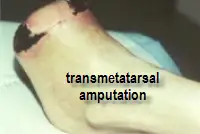diabetic amputation
AUTHOR: Marc Mitnick DPM home --> diabetic amputationconsiderations in a diabetic amputation
Unfortunately, not all limbs that exhibit diabetic foot infections or ulcerations are able to be salvaged. There are instances where amputation of a toe, foot, or below knee amputation is actually in the patient's best interest. "Best interest" can include saving their life.
There is a multitude of considerations that must be addressed in the decision of a diabetic amputation. The situation will vary from patient to patient. Different amputation levels offer different advantages and disadvantages.
Patient preference of course is part of the equation, but in an ideal situation the patient would be happiest with the least amount of amputation. Many times this is possible, however, in a large percentage of cases this is not possible.
Ability of the wound to heal beyond the patient's preference, other considerations include the ability of the wound to heal. The level of diabetic amputation chosen must give the patient the best chance of healing, otherwise, the patient is once again looking at a chronic wound that requires regular ongoing medical care with the inability of the patient to get on with their life. Perhaps worse than that, it sets the patient up for possible further amputations at a higher level. So once again the patient is faced with more surgery along with the risks of surgery. Keep in mind that many diabetics are sick people with heart and kidney disease and the re-introduction of general anesthesia, along with the stress of surgery is not in the best interest to the patient.
Osteomyelitis In patients with osteomyelitis the amputation needs to be far enough away from the infected bone in order to avoid a "new" bone infection.
Vascular status The patient's vascular status (circulation) must be assessed. If the level of anticipated diabetic amputation does not exhibit adequate blood flow than the proposed procedure is doomed to failure before it begins. Without adequate circulation the surgical wound that is created will not heal. Any proposed skin flaps will also not heal. Blood is what allows wounds to heal. Too little blood equals no wound healing. This will lead to post operative complications. Again, the worse scenario is performing an amputation at a level that is poorly vascularized as it will ultimately require a second surgery.
Overall patient health The overall health and return to a somewhat normal life need to be addressed. A sedentary patient will place far less demands on the amputated limb than the reasonably young individual who would like to return to their normal activity level which usually includes participation in athletic activities. In those who hope to return to an active lifestyle the level of diabetic amputation becomes crucial. Because an amputation changes the biomechanical considerations in gait, sometimes an amputation further up may afford the patient a prosthesis that will better function in a more active lifestyle.

|
Even though in this case the psychological and cosmetic factors would suggest a lesser amputation, the desired lifestyle the patient hopes to resume would necessitate a more aggressive amputation in an effort to construct a prosthesis to allow the patient to resume his or her activity level. In this scenario the patient's vision of the future outweighs the medical criteria in terms of what level to do an amputation.
On the other end of the spectrum is the patient facing an amputation who is more sickly. Not only do they have a foot wound or infection that shows no signs of healing, but their overall health status is also a concern. These types of patients are usually poorly controlled diabetics. They also in many cases exhibit heart disease and kidney disease. Many will have nutritional deficiencies. If a person is malnourished, their tissues will not heal and any proposed procedure is doomed to failure. Malnutrition will also inhibit those whose limbs are being salvaged by wound care teams.
Many people with chronic foot wounds have been dealing with this problem for months if not years. They are seen constantly in wound care centers, occasionally hospitalized with infections and other diabetic related problems. The longer a wound is open with the inability to close it, the greater the chances it will never close. A chronic open wound is always susceptible to infection. If the blood sugars are always elevated the chance of infection and the inability to eradicate the infection also increases.
There are also scenarios where a patient has a foot wound that finally closes, the patient is discharged, only to return a few months or a year or two later with a new wound in the same location. Yes, closing the wound should be the initial treatment of choice, but inevitably if the wound keeps recurring and the doctor and patient cannot identify things the patient may be doing to himself (poor fitting shoes, poor hygiene, poor diet) that is causing recurring wounds, then again, amputation should at least be in the discussion.
Off-loading or reducing pressure on the wounded foot puts greater demands on the unaffected foot. This in many instances will cause eventual breakdown somewhere on the good foot and now the problem has doubled. For this reason, many patients reach a tipping point where they are better off with an amputation rather than an endless schedule of doctor's appointments and wound care treatment at home.
I think it is fairly safe to say that given the choice no one would like an amputation of their limb, however, there are instances where there is no choice. A septic (infected) foot can lead to death. In the less severe scenarios people in discussion with their doctor should arrive at a realistic decision as to what measures will allow them to get back to the type of lifestyle they envision for themselves. As you can see from this discussion there is no "cookie cutter" formula.
mortality considerations in diabetic ulcer and amputation
For those who suffer from diabetic ulcers or undergo lower extremity amputations there is the additional issue of mortality. Not so much from the ulcer or amputation itself, but rather from the underlying medical issues that lead up to these problems (or the inability to salvage a limb due to underlying causes), the life expectancy of a diabetic is very much diminished, more so if both limbs are amputated. If you look at the graph below, you will see that five year survival is less then some of the more common cancers.

|
Once again this the reason diabetics, even those diabetics who have no symptoms, need to take their disease seriously. It is much easier to prevent an ulcer or amputation then it is to cure one.
REFERENCES
Want more information? CLICK HERE


Recent Articles
-
Vitamin D impact on health
Feb 06, 23 07:17 PM
Researchers are suggesting that the effectiveness of Vitamin D in fighting and preventing disease is predicated on a persons body mass index (BMI). The thinner the person the greater the positive impa… -
Foods to speed up healing
Feb 01, 23 02:41 PM
One of the best ways to help yourself heal faster after surgery is to eat well. Getting the proper nutrition will provide your body with the essentials it needs to promote healing. Here is a suggestio… -
Cancer and Type 2 Diabetes
Jan 25, 23 04:52 PM
An article revealing that older type 2 diabetics have a higher incidence of cancer then non-diabetics. It is suggested that cancer may surpass CVD as the number one cause of death in older diabetics. -
Does glucosamine or MSM reduce arthritis pain?
Jan 22, 23 01:41 PM
A good review of the possible benefits to taking glucosamine, chondroitin or MSM for arthritis. Always beware of the possible side effects of over the counter supplements. -
shin splints
Jan 18, 23 05:12 PM
A great review on the various causes of shin splints, along with treatment options. -
Whats new in skin cancer?
Jan 15, 23 08:32 PM
A presentation of newer skin protection combinations in an effort to better protect the skin from the hazards of sun exposure. -
Causes and risk factors of warts
Jan 14, 23 05:02 PM
A good review of the causes of warts and protective measures you can take to prevent developing them. -
Do chronic wounds need to be dressed daily?
Jan 11, 23 02:18 PM
Because of supply chain shortages as well as staffing shortages particularly during the pandemic, many institutions extended the time between dressing changes for chronic wounds. Is this really the be… -
Food choices that raise your risk of type 2 diabetes
Jan 08, 23 10:07 AM
A good review of how blood sugars can become elevated and the harm that can do. Certain food groups have a tendency to raise your blood sugars and should be avoided. -
Outcome stats from Scarf bunionectomy
Jan 03, 23 03:04 PM
The Journal of Foot and Ankle Surgery recently reported a meta analysis of outcomes in 1583 Scarf bunionectomies that met their inclusion criteria. Adverse events did not seem to be any better or wors…